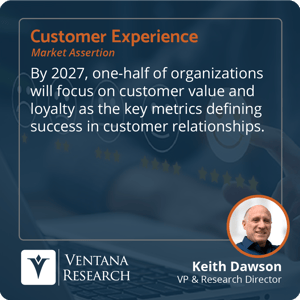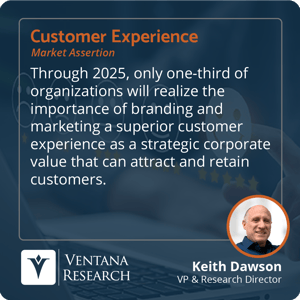The environment around customer experience is being disrupted by a series of technical and organizational shifts ranging from artificial intelligence to work-from-home to deep customer analytics. When times change, it’s helpful for people to have a framework to organize their thinking and actions. I believe there are two dominant frameworks used to organize business approaches to customers. One is rooted in the efficiency of the contact center (let’s call it “CC thinking”), and the more marketing-centric framework is based on maximizing customer value (for argument’s sake, “CX thinking”).
Managing customer experience is not the same thing as running a contact center. Being good at one doesn’t mean success at the other. They’re connected, but look at similar problems through different frames of reference. The confusion creates a disconnect, pitting workers who should be striving toward the same goals to work at cross-purposes, compete for resources and speak different languages.
Consider the idea of a contact center. It is an organization’s figurative front door. It is primarily reactive to customer behavior and one of the only places in an organization where workers are dedicated to responding to customers. Now, broaden the scope of concern beyond the interaction: CX controls important things that happen before and after the interaction. It looks to quantify and maximize the relationship, extracting maximum value from customers. Unlike contact center management, it is often the responsibility of people in many different roles with different experiences and backgrounds. Where the contact center works toward efficiency as the goal, customer experience revolves around revenue.
People in and around centers focus on interactions and cases. Speed is their goal. They are alert to customer requests and driven to close the matter as inexpensively as possible. This is the default mode of agents, supervisors and many managers.
CX professionals, by contrast, are driven by analytics and data in pursuit of outcomes like value, growth, longevity and revenue. They focus on longer-term journeys and shaping relationships by orchestrating interactions and behavior.
Each mode of thinking has pros and cons. Contact center thinking has created a miraculously fine-tuned engine of interaction productivity. It establishes an environment in which everyone knows what they need to do, using technology that is well-understood and mature. On the downside, it takes so much effort to manage that it is harder for decision-makers to focus on the bigger picture. CC thinking emphasizes problems rather than opportunities and often views customers through that lens. It has a hard time anticipating and dealing with the unexpected: complex, extra-long interactions or customer volatility. It fits customers and their problems into rigid templates to handle them at scale, and as a result, isn’t as good at managing outlier events.
CX thinking solves different problems. First, it takes what the contact center does and applies it to the broader problem of influencing customers to do what you want them to do. It uses vaster data resources to build pictures of customers as individuals and groups likely to behave in certain ways. CX thinking finds and acts on moments of influence that emerge. It does this by encouraging multiple departments and processes to complement each other. For example, it uses the contact center as an instrument for achieving business goals rather than as a way of triaging customer issues.
The primary downside of CX thinking is that it’s rare that someone is directly in charge of it. And when someone is, it’s not clear whether they have the authority to make decisions and changes to support their goals or course correct. With broad CX goals, it is often less clear what steps need to be taken (and by whom) to execute a plan. Does the service department answer to the needs of sales and marketing? Does a marketer understand the nuances of different types of service (field, self-service, agented, etc.)? And how can the CX quest for leads and sales affects costs and behavior downstream?
It also brings a wider set of tools that aren’t familiar across business units, particularly those that are more deeply analytic and predictive. And it doesn’t always operate with a familiarity of the specific resource requirements of the contact center (i.e., agents).
Organizations should care about reconciling these two frameworks because, if not, experiences will degrade, and opportunities will be lost. For example, in a declining (or static) economy, the contact center is one of the first places organizations look to cut costs via headcount. Senior management might know perfectly well that staffing reductions cause longer hold times, agent burnout and attrition. Their attitude may be to say, “Okay, we can live with these CC-focused consequences because they aren’t experienced directly in terms of customer effects.” But those effects are still there, downstream, in the form of lower revenue, customer churn or dissatisfaction.
Senior managers need to ask the key question: Do existing cost models assess the downstream customer impacts of cost-cutting on things like loyalty, long-term customer value and so forth?
People with a CX focus are more likely to use customer analytics, often with a predictive component. They’re more likely to consider customers as part of larger groups with common qualities. A person with a CC focus will be more likely to look at the same technologies through the lens of making agents more productive and efficient. They’re more likely to see self-service as a mode of deflection than as a way of capturing relevant info about the customer for relationship-building efforts.
Not to oversimplify, but from the perspective of the contact center, the goal is to maximize performance metrics such as call volume, response time or first-call resolution. Agents prioritize meeting these key performance indicators to ensure they hit performance targets and earn incentives. However, from the perspective of the organization as a whole, the goal may be to prioritize customer satisfaction and experience. The organization may want to measure metrics such as customer retention rates or customer lifetime value, which reflect overall value and loyalty of customers.
If the organization prioritizes customer satisfaction and experience, it may require agents to take more time to fully understand and address customer needs. This may result in longer handling times but higher  customer satisfaction rates and potentially increase long-term customer loyalty and revenue.
customer satisfaction rates and potentially increase long-term customer loyalty and revenue.
With two distinct ways of looking at customers, individuals need to know when to lean into one or the other. When there are sudden shifts in external conditions, CC thinking excels because you can rely on its ability to operate consistently at scale. However, when launching a new product or service, the organization may need to focus more on CX thinking to ensure that customers understand the value proposition and are excited about the offering. This may involve investing more time and resources to train agents on the new product or service and developing scripts and materials that focus on the customer's needs and preferences.
To prosper in the coming age of complexity, consider that this is not a binary choice. You can’t and shouldn’t be either a CX thinker  or a CC thinker. You have to be both. You have to act from multiple points of view when making plans about technology deployments, including platforms, AI, workflow automation, analytics and knowledge resources. From inside the contact center, you have to put yourself into the mindset of the CX actors in the rest of the organization. Both modes encourage different types of outcomes and can lead to success in different ways.
or a CC thinker. You have to be both. You have to act from multiple points of view when making plans about technology deployments, including platforms, AI, workflow automation, analytics and knowledge resources. From inside the contact center, you have to put yourself into the mindset of the CX actors in the rest of the organization. Both modes encourage different types of outcomes and can lead to success in different ways.
Within a few years, we predict that organizations will come face-to-face with the disconnect created by this duality. Many will see how important it is to focus on customer value and loyalty to measure success in customer relationships. That’s the growth of CX thinking.
At the same time, only a portion of firms will recognize how important good experiences are to building a brand and attracting and keeping customers. That’s the persistence of CC thinking.
These predictions suggest a need to collaborate more, to use more common technology platforms and share more sources of data in the quest for a whole-organization approach to customers.
Regards,
Keith Dawson

 customer satisfaction rates and potentially increase long-term customer loyalty and revenue.
customer satisfaction rates and potentially increase long-term customer loyalty and revenue. or a CC thinker. You have to be both. You have to act from multiple points of view when making plans about technology deployments, including platforms, AI, workflow automation, analytics and knowledge resources. From inside the contact center, you have to put yourself into the mindset of the CX actors in the rest of the organization. Both modes encourage different types of outcomes and can lead to success in different ways.
or a CC thinker. You have to be both. You have to act from multiple points of view when making plans about technology deployments, including platforms, AI, workflow automation, analytics and knowledge resources. From inside the contact center, you have to put yourself into the mindset of the CX actors in the rest of the organization. Both modes encourage different types of outcomes and can lead to success in different ways.








